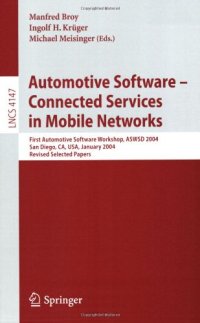
Ebook: Automotive Software – Connected Services in Mobile Networks: First Automotive Software Workshop, ASWSD 2004, San Diego, CA, USA, January 10-12, 2004, Revised Selected Papers
Author: Christian Ferdinand Reinhold Heckmann (auth.) Manfred Broy Ingolf H. Krüger Michael Meisinger (eds.)
- Genre: Education // International Conferences and Symposiums
- Tags: Special Purpose and Application-Based Systems, Software Engineering, Computation by Abstract Devices, Logics and Meanings of Programs, Simulation and Modeling
- Series: Lecture Notes in Computer Science 4147 : Information Systems and Applications incl. Internet/Web and HCI
- Year: 2006
- Publisher: Springer-Verlag Berlin Heidelberg
- Edition: 1
- Language: English
- pdf
Software development for the automotive domain is currently subject to a silent revolution. On the one hand, software has become the enabling technology for almost all safety-critical and comfort functions o?ered to the customer. A total of 90 % of all innovations in automotive systems are directly or indirectly - abled by software. Today’s luxury cars contain up to 80 electronic control units (ECUs) and 5 di?erent, inter-connectednetworkplatforms, overwhich some700 software-enabled functions are distributed. On the other hand, the complexity induced by this largenumber of functions, their interactions, and their supporting infrastructure has started to becomethe limiting factor for automotive software development. Adequate management of this complexity is particularly important; the following list highlights three of the corresponding challenges: First, the dependencies between safety-critical and comfort functions are rapidly increasing;a simple example is the interplay of airbag controland power seat control in the case of an accident. Careful analysis and design of these dependencies are necessary to yield correct software solutions. Second, advances in wired and wireless networking infrastructures enable - terconnection between cars and backend service providers (e.g., to call for help in cases of emergency), between cars and devices brought into the car by drivers and passengers (such as cell phones, PDAs, and laptops), and even among cars. This dramatically shifts the focus from the development of individual software solutionsresidingondedicatedECUstotheirdistributionandinteractionwithin and beyond car boundaries.
This book constitutes the thoroughly refereed post-proceedings of the First Automotive Software Workshop, ASWD 2004, held in San Diego, CA, USA in January 2004.
The 10 revised full papers presented were carefully reviewed and selected from 26 lectures held at the workshop, that brought together experts from industry and academia, working on highly complex, distributed, reactive software systems related to the automotive domain.
The papers presented are organized in topical sections on quality assurance, real-time control, services and components, as well as model-based development and tools.